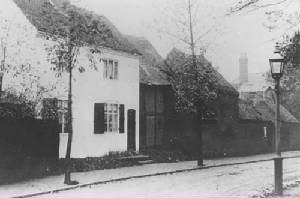|
Handsworth
![Wood Lane, c 1880 - 1900 [click for larger image]](sitebuildercontent/sitebuilderpictures/.pond/woodlane.jpg.w300h187.jpg)
Handsworth is an inner city suburb of Birmingham in the West Midlands of England. As Handsworth Urban District it was part of Staffordshire until it was incorporated, controversially, into Birmingham Corporation in the year 1911.
The name Handsworth originates from its Saxon owner Hondes and the Old English word weorthing, meaning
farm or estate. It was recorded in the Domesday Survey of 1086, as a holding of William Fitz-Ansculf, the Lord of Dudley,
although at that time it would only have been a very small village surrounded by farmland and extensive woodland.
From the 13th century through to the 18th century, it remained a small village until Matthew Boulton who lived at the nearby
Soho House set up the Soho Manufactory in 1764 on Handsworth Heath. Accommodation was built for the factory workers, the village
quickly grew, and in 1851, there were over six thousand people living in the township. Forty years later over thirty-two thousand
were counted at the census of 1881, and by 1911, this had more than doubled to 68,610.
The development of the built environment was sporadic and many of Handsworth's streets display a mixture of architectural
types and periods - among them some of the finest Victorian buildings in the city. Handsworth has two grammar schools - Handsworth Grammar School for boys and King Edward VI Handsworth Girl's Grammar School. It also contains Handsworth Park completing in 2006 a major
restoration, the vibrant shopping of Soho Road, St. Mary's Church, Handsworth containing the remains of the founders of the
Industrial Revolution - Watt, Murdoch and Boulton - and the unique bookbindery, source of specialist and antique books about
the area - 'Bookbane' - in Nineveh Road.
Birmingham historian Dr.Carl Chinn noted that during WW2 the boundary between Handsworth and the outlying suburb of Handsworth
Wood marked the line between being safe and unsafe from bombing, with Handsworth Wood being an official evacuation zone. (ref:
Carl Chinn (1996) Brum Undaunted: Birmingham During the Blitz, Birmingham Library Services) During the Second World War, West
Indians had arrived as part of the colonial war effort, where they worked in Birmingham munitions factories. Post-war, a rebuilding
programme required much unskilled labour and Birmingham's industrial base expanded, significantly increasing the demand for
both skilled and unskilled workers. During this time, there was direct recruitment for workers from the Caribbean and the
area became a centre for Birmingham's African-Caribbean community.
The West Indian population in Birmingham numbered over 17,000 by the 1961 census count. In addition, during this time,
Indians, particularly Sikhs from the Punjab arrived in Birmingham, many of them working in the foundries and on the production
lines in motor vehicle manufacturing.
civil unrest
Although these groups contributed to the local economy, they have suffered much racism and in Handsworth, and neighbouring
Lozells, the problems and discontent escalated in September 1985 (an earlier riot took place in 1981). As in many parts of
Britain, the conflict between black people in Birmingham and the police was a long-standing one. Blanket raids on black meeting
places and a "stop and search" policy increased the tension between the police and the black community.
Many of these problems were focused upon attempts by media regulators continually trying to crush the "free radio" (pirate radio) station PCRL. This Handsworth station specifically catered to the West Indian population and gave voice to discontent. But the station
also has a long and continuing history of attempting to provide not only a media outlet for alternative points of view, but
support for a cottage industry of self-help programmes. PCRL carried programs that attempted to focus US media attention on
the problems faced by PCRL and the West Indian community in Handsworth.
After the Handsworth riots caused a huge publicity shock to world perception of British toleration, the heavy handed approach on the community was slackened,
although a weakened PCRL remained unlicensed. Local government was forced into building new community relations as a way of
managing both racial and cultural differences. Encouragement was provided by arts organisation like West Midlands Ethnic Minority Arts Service and private groups such as Shades of Black, which works closely with the community and is still going strong today.
Handsworth Wood

Handsworth Wood is a loosely defined area in the north west of Birmingham, England, with a population in the region
of 25,000. It is also a ward within the formal district of Perry Barr. Located within the metropolitan county of the West
Midlands since 1974, it was previously a part of the county of Staffordshire. Handsworth Wood is regarded by estate agents
as "upmarket" in comparison to the neighbouring district of Handsworth, but is disadvantaged by its extra distance from Birmingham
city centre. Local amenities include: King Edward VI Handsworth Girl's Grammar School and Handsworth Grammar School, Soho Road, St. Mary's Church, Handsworth and Handsworth Park.
Birmingham historian Dr.Carl Chinn noted that during WW2 the boundary between Handsworth and Handsworth Wood marked the line between being safe and unsafe from
bombing, with Handsworth Wood being an official evacuation zone. (ref: Carl Chinn (1996) Brum Undaunted: Birmingham During
the Blitz, Birmingham Library Services)
There is a Birmingham City electoral ward called Handsworth Wood comprising part of Handsworth and nearly all of Handsworth
Wood made up of distinct cultures and built environments - the once salubrious Victorian suburb, now "inner-city" Handsworth,
consisting of some of the finest Victorian houses in the city, increasingly being refurbished to complement the £9 million
restoration of Handsworth Park, and Handsworth Wood dominated by characteristically suburban pre-war semi-detached and detached
properties. Handsworth Wood is home to the University of Central England's Hamstead campus.
|
 |
|
 |
 |
![Handsworth Wood Railway Station [click for larger]](sitebuildercontent/sitebuilderpictures/.pond/handsworth_woodrailwaystation.jpg.w300h167.jpg)
|
| Handsworth Wood Railway Station 1896 - 1941 |
|
|
the original building dates
from the 15th century
the Wikipedia entry
the Wikipedia entry
(1896 - 1941)
|
|
 |
 |
|
 |
|
|
 |
|
|
|

